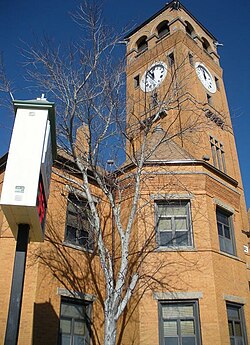
Back توسكيجي Arabic توسكيجى ARZ تاسکیقی AZB Таскігі Byelorussian Тъскиджи Bulgarian টাসকিজি, অ্যালাবামা Bengali/Bangla Tuskegee (Alabama) Breton Tuskegee Catalan Таскиги (Алабама) CE Tuskegee CEB
Tuskegee, Alabama | |
|---|---|
 The Macon County Courthouse in Tuskegee was added to the National Register of Historic Places on November 17, 1987. | |
| Nickname: Thou Pride of the Swift Growing South | |
 Location in Macon County, Alabama | |
| Coordinates: 32°25′53″N 85°42′24″W / 32.43139°N 85.70667°W | |
| Country | United States |
| State | Alabama |
| County | Macon |
| Government | |
| • Mayor | Lawrence F. Haygood, Jr. |
| Area | |
| • Total | 17.33 sq mi (44.89 km2) |
| • Land | 17.06 sq mi (44.19 km2) |
| • Water | 0.27 sq mi (0.70 km2) |
| Elevation | 463 ft (141 m) |
| Population | |
| • Total | 9,395 |
| • Density | 550.7/sq mi (212.63/km2) |
| Time zone | UTC-6 (CST) |
| • Summer (DST) | UTC-5 (CDT) |
| ZIP codes | 36083, 36087, 36088 |
| Area code | 334 |
| FIPS code | 01-77304 |
| GNIS feature ID | 0128211 |
| Website | tuskegeealabama |
Tuskegee (/tʌˈskiːɡi/ tuh-SKEE-ghee[3]) is a city in Macon County, Alabama, United States. General Thomas Simpson Woodward, a Creek War veteran under Andrew Jackson, laid out the city and founded it in 1833. It became the county seat in the same year and it was incorporated in 1843.[4] It is the most populous city in Macon County. At the 2020 census the population was 9,395,[2] down from 9,865 in 2010 and 11,846 in 2000.
Tuskegee has been important in African-American history and highly influential in United States history since the 19th century.[peacock prose] Before the American Civil War the area was developed for cotton plantations, dependent on enslaved African-American people.
After the war many freedmen continued to work on plantations in the rural area, which was devoted to agriculture, primarily cotton as a commodity crop. In 1881 the Tuskegee Normal School (now Tuskegee University, a historically black college) was founded by Lewis Adams, a former slave whose father, Jesse Adams, a white slave owner had allowed him to be educated. Its first founding principal was Booker T. Washington, who developed a national reputation and philanthropic network to support education of freedmen and their children.
In 1923, the Tuskegee Veterans Administration Medical Center was established, initially for the estimated 300,000 African-American veterans of World War I in the South, when public facilities were racially segregated. Twenty-seven buildings were constructed on the 464-acre campus.[5]
The city was the subject of a civil rights case, Gomillion v. Lightfoot (1960), in which the United States Supreme Court ruled that the state legislature had violated the Fifteenth Amendment in 1957 by gerrymandering city boundaries as a 28-sided figure that excluded nearly all black voters and residents, and none of the white voters or residents.[6] The city's boundaries were restored in 1961 after the ruling.
- ^ "2020 U.S. Gazetteer Files". United States Census Bureau. Retrieved October 29, 2021.
- ^ a b "Tuskegee city, Alabama: 2020 DEC Redistricting Data (PL 94-171)". U.S. Census Bureau. Retrieved March 28, 2022.
- ^ See "Pronunciation of Tuskegee." thefreedictionary.com.. Retrieved: October 3, 2010.
- ^ Sarah Lawless, Auburn University (June 25, 1957). "Tuskegee". Encyclopedia of Alabama. Retrieved September 20, 2017.
- ^ "Tuskegee Veterans Administration Medical Center Celebrates - 85 Years of Service", press release, Central Alabama Veterans Health Care System (CAVHCS), 2008
- ^ Cite error: The named reference
alencwas invoked but never defined (see the help page).
© MMXXIII Rich X Search. We shall prevail. All rights reserved. Rich X Search


